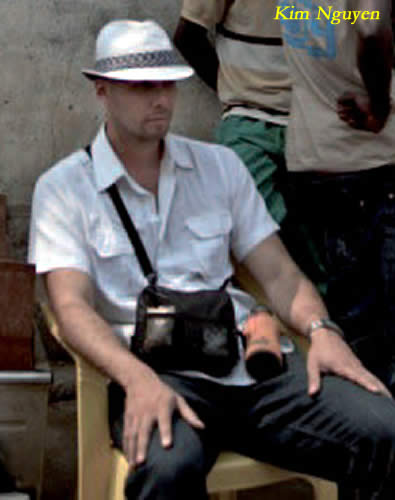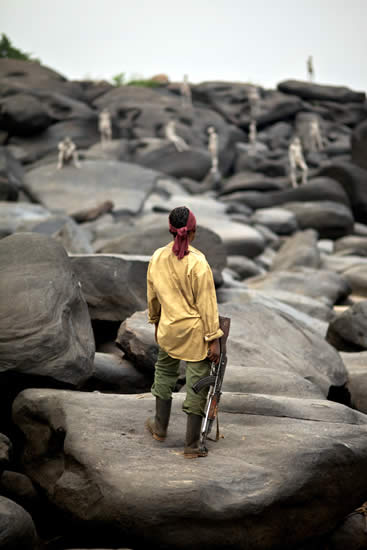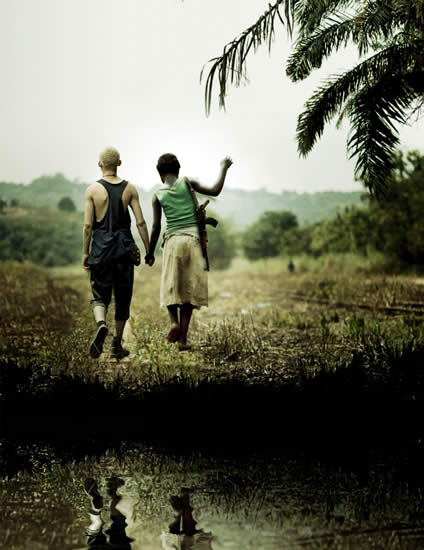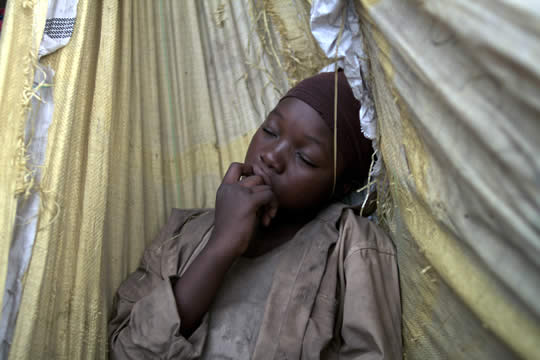 In War Witch, nominated for the Best Foreign Language Film Oscar, Komona (Rachel Mwanza) is only 12 years old when she is kidnapped by rebel soldiers and enslaved to a life of guerrilla warfare in the African jungle. Forced to commit unspeakable acts of brutality, she finds hope for survival in protective, ghost-like visions (inspiring a rebel chief to anoint her “War Witch”), and in a tender relationship with a fellow soldier named Magician (Serge Kanyinda). Together, they manage to escape the rebels’ clutches, and a normal life finally seems within reach. But after their freedom proves short-lived, Komona realizes she must find a way to bury the ghosts of her past.
In War Witch, nominated for the Best Foreign Language Film Oscar, Komona (Rachel Mwanza) is only 12 years old when she is kidnapped by rebel soldiers and enslaved to a life of guerrilla warfare in the African jungle. Forced to commit unspeakable acts of brutality, she finds hope for survival in protective, ghost-like visions (inspiring a rebel chief to anoint her “War Witch”), and in a tender relationship with a fellow soldier named Magician (Serge Kanyinda). Together, they manage to escape the rebels’ clutches, and a normal life finally seems within reach. But after their freedom proves short-lived, Komona realizes she must find a way to bury the ghosts of her past.
In 2002, Kim Nguyen wrote and directed his first feature: LE MARAIS. The film received 6 Jutra nominations including Best Film and Best Director. His second feature, TRUFFE, which he wrote, directed and produced, stars Roy Dupuis and was the opening film at Montreal‘s FANTASIA Film Festival in 2008. It also garnered international awards including Best Film at the Karlovy Vary Fresh Film Festival. In 2009 he directed LA CITE, an international co-production starring Jean Marc Barr. WAR WITCH, his latest feature was entirely shot in the Democratic Republic of the Congo in July 2011 and had its world premiere in competition at the Berlin International Film Festival, North American Premiere at Tribeca Film Festival where it won awards at both.
Bijan Tehrani: Your film is amazing and unbelievably good.
Kim Nguyen: Thank you!
BT: It’s almost like a fantasy. How did you come up with the idea for making the War Witch?
KN: I initially read a true story about a Burmese child, Johnny Htu, 9 yrs old, who woke up one day and said he was the reincarnation of God. He was part of an army of rebels who fought against soldiers of the government so it led me to want to tell the story of a child who is a semi-deity and starts leading an army of rebel soldiers. Doing research for a number of years, it eventually led me to sub-Saharan Africa where I quickly realized that the main character had to be a girl rather than a boy. I felt that there hadn’t been a voice given to such a complex human character and I felt these human tragedies were very well adapted to the film medium, to make a story about.
BT: This film takes you on a strange journey that seems unbelievable and I know that there are things happening in this world which we don’t believe because we don’t have contact with them. How close to reality is this?
KN: Most of the things that you see are things that I read about, that I saw first-hand or that I learned first-hand from ex-child soldiers I met in Burundi while researching for the film. However, it’s a reality that’s completely distorted by the point of view of the character. The film doesn’t pretend to be objective. It is subjective in the eye of the main character. That is what I wanted to try to achieve.
BT: I think this is the best way of telling about what is happening in the real world because sometimes documentaries don’t work any more.
KN: What you are saying is interesting because I watched documentaries about child soldiers that were supposed to be objective, in the sense that they showed the raw brutality, the blood and all that.. but what I wanted to convey was how the child creates a psychological protective system to accept violence and to deal with it. So in a way we don’t see a lot of violence and before we see the blood fall, you know she says before she sees the red meat fall on the floor, she sees ghosts. It’s a metaphor for how these kids, through the use of drugs, through indoctrination and a belief system, learn to cope with a world that is so violent. In a way, the subjectivity of the film can become more objective on an emotional level.
 BT: I think also one of the successes of the film is you don’t just witness what is happening but become a child soldier yourself as you are watching the film. You identify with the characters and that is why you understand what is going on.
BT: I think also one of the successes of the film is you don’t just witness what is happening but become a child soldier yourself as you are watching the film. You identify with the characters and that is why you understand what is going on.
KN: Thank you. That’s what I really wanted to achieve: not to be objective but to put the viewer in the eye of the beholder, in the eye of the child-soldier. We really were dogmatic in the point of view that we adopted. We filmed so many wide shots, beautiful landscapes because at one point all of your team tells you we should have establishing shots. They’re beautiful shots but they’re not in the film, we took them all out because they brought you away from the life of that character.
BT: The performance of all the characters, especially Rachel, is amazing. How did you find these actors and how did you work with them?
KN: Rachel was a kid living in the streets. She had been living off the streets since she was six years old and she just had this raw truth in the way she would act and portray the girl. She didn’t know how to read so our way to work was with directed improvisations and we shot the film chronologically in order for her to understand the story. The whole process was really interesting and freeing in a way because once you start shooting in continuity, things become clearer as the film evolves.
BT: How did you come up with the visual style of your film? It is so dynamic, wild and subjective.
KN: Thank you. I didn’t have an expectation of what the film should look like but I did start drawing some reference boards and I used some pictures as references. They weren’t dogmatic: I would show them to the crew as suggestions for the scenes but most importantly, we were always at the service of the performance and the authenticity. We didn’t shoot with marks that the actors had to put their feet on; we were really at their service. They could go basically anywhere they wanted on the set. At the same time, I had these visual references. For example, at one point Komona just killed many many soldiers and then you see almost a hundred ghosts in front of you on these big black rocks while her back is to us. That is something I drew beforehand and I said this is what I want to conclude the scene with, let’s film accordingly, that’s where we’re aiming. We would divide the day the evening before or the morning before shooting: we would look at how the characters felt on set and where they felt like going and we would adapt the day accordingly.
BT: The music in the film plays so much into the style of the film and to the feeling the audience gets.
KN: Thank you. To me, this was an homage to the most beautiful afro-beat musics I’ve ever heard: the Angolese music of the 70s. I allowed myself to digress from the Congolese music – I hope the spectator forgives me – but there were such beautiful pieces of music that I had to put them in there. We did try different musical esthetics on the film: at one point, I had a beautiful theme by a composer but in the end it just didn’t work. We kept it really simple.
BT: For me as a film critic and a filmmaker, this is such an amazing film, I really hope it wins the Oscar. How do you see your chances of winning the award and how has the nomination helped the film?
KN: More and more, as I have been making films, it’s become more about the road than the final result. It’s important to fight for it and go for it. Of course Haneke has such a legacy I think he’s our biggest contender in the competition. However, having seen all the films except for Kon-Tiki, I’m really happy to be part of the nominees and all my colleagues have done remarkable films. I think our edge is perhaps on the formal side: we have a narrative that leads away from the standard narrative which makes its originality. But again Haneke has such a legacy that I am not sure we can convince people that our movie should win the Oscars! There’s such a strong vibe around Amour that he might just win or be a strong contender for Best Film.
BT: That’s a beautiful film too but I think yours is a unique film and it is something cinema needs – directors with fresh, new ideas for the future of cinema.
KN: Thank you! I am so glad to hear that from a colleague. It’s very appreciated.

